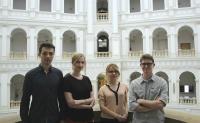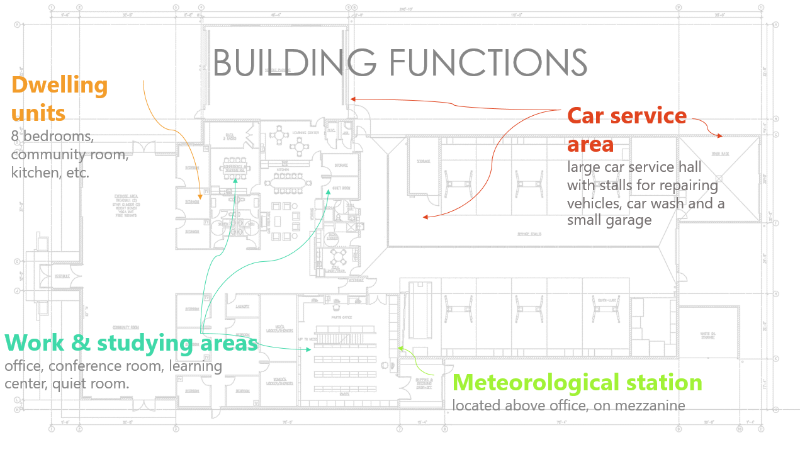An Engineering Journey from Poland to Chile
Four students of the Warsaw University of Technology worked intensively for eight months to design the best possible HVAC system for a weather station building on one of the Diego Ramirez Islands in Chile. It was worth the effort, as the team has won an international competition.
It all began in October 2016. “Karolina Kowal found an announcement on the website of ASHRAE, an American association, about a project competition for students and she suggested that we participate,” says Bartłomiej Tokarzewski. “I liked the idea a lot, so I started looking for interested people among University students right away. 30 people came forward. In the end, we had a team of four: Karolina, me, Dagmara Ćwiek and Tomasz Kolsicki. We all study Environmental Engineering at the Faculty of Building Services, Hydro and Environmental Engineering.”
Heading in the Right Direction
In the previous edition of ASHRAE Student Design Competition, there were four categories: HVAC Design Calculations, HVAC System Selection, Integrated Sustainable Building Design (ISBD) and The Applied Engineering Challenge. Our students entered the HVAC System Selection category. The task was to propose three concepts for a HVAC system (i.e. heating, ventilation and air conditioning) for a weather station building located in one of the Diego Ramirez Islands in Chile, 100 km away from Cape Horn. The building housed living quarters, office space, a small server room and a workshop floor for car engine testing.
In fact, design was only the very first stage of the competition. Because afterwards, the participants had to choose the best of their designs. They examined 11 criteria in their evaluation: initial cost; operating cost; controllability; flexibility; reliability; maintainability; low environmental impact; energy usage; comfort and health; synergy with architecture; and the LEED rating. Interestingly, weights were assigned to the criteria by the entrants themselves. Furthermore, the concepts had to be site-specific and in conformity with ASHRAE standards.
“We had our own ideas and visions, but we knew we needed expert consultation as well, to make sure we were heading in the right direction,” Bartek says.
That is why the students approached companies and selected HVAC experts. They also sought assistance from three consultants: Piotr Bartkiewicz, Ph.D. Eng., from the Warsaw University of Technology, Paweł Wargowski, Ph.D. Eng., from the Technical University of Denmark and Maciej Sobczyk, CEO at Geoclima Mechanical Engineering Ltd, Vancouver BC Canada. They did it all to learn as much as possible about the available equipment and to include that input in their concept to make the proposed systems really feasible.
Everyone Wanted to Be the Best
“We all met once a week,” said Bartek. “That’s when we assigned the tasks. Then everyone did their thing on their own, and when we met, we summarized and planned for subsequent project stages. We worked the hardest from February to May.”
In such initiatives, team spirit is important, this is clear. But in this case, an equally important part was... competition. “I designed one system, Karolina designed another and Dagmara did one, too,” Bartek explained. “Everyone wanted their system to turn out to be the best. We compared all of them against a baseline system, which we had to design too, so in total we created four systems instead of three. When we counted the score, it showed that Karolina’s solution won.”
Goal: To Showcase the Project Internationally
Bartek admits that they did not expect to win the competition. “We took part in order to put ourselves to a test, to show what we are able to do, but also to learn. We knew that the Americans attached a lot of importance to formal matters, so we thoroughly analyzed the competition guidelines and we did the things that got you points to the best of our ability. Maybe we won because we used immersion cooling in our project? I think no one else did that.”
Now the team has a new task to do – to raise funds that will allow the four of them and doctor Bartkiewicz, one of the consultants, to attend an ASHRAE meeting in Chicago in January. The winners will present their projects there, in a plenary session. “As an award in the competition, travel expenses are only paid for one team member,” Bartek said. “And all of us want to go there, because we all worked hard to succeed.”
However, the plans are not over yet. Our students want to enter the next edition of the ASHRAE competition, this time in the Integrated Sustainable Building Design (ISBD) category.
For more project details visit its dedicated website
Agnieszka Kapela
Office for Promotion and Information









